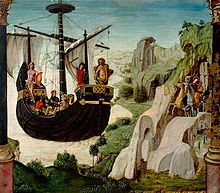Argo
[3] Diodorus Siculus records that some thought the name was derived from an ancient Greek word for "swift" to indicate that the ship was designed to move quickly.
The ship was built for travel in the open sea and designed to move quickly with the assistance of a sail.
[8] The prow of the ship was also made with a special piece of oak from Dodona, an area sacred to Zeus.
[10] The ship carried enough supplies, such as vases holding water, for the collective crew and lasted four days before having to refuel.
Herodotus claimed the bronze tripod was given to Triton after the Argonauts got lost in Lake Tritonis and needed assistance.
[17] The Argo was said to be loved by the Nereids, who alongside Triton helped guide the ship at dangerous times in the Argonauts' journey.
Several authors of antiquity (Apollonius Rhodius, Pliny,[21] Philostephanus) discussed the hypothetical shape of the ship.
Generally she was imagined like a Greek warship, a galley, and authors hypothesized that she was the first ship of this type that had gone out on a voyage on the high seas.
[22] The version of the Argo that appears in the 1963 film Jason and the Argonauts was modeled after a Greek warship, with shields lining the side of the boat.
Filmmakers gave this head the practical effect of being able to open and close its eyes when speaking to Jason.





